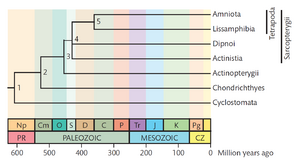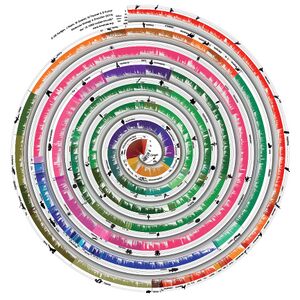Biology:Timetree


A timetree is a phylogenetic tree scaled to time.[3] It shows the evolutionary relationships of a group of organisms in a temporal framework.[3]
Therefore, if living organisms are represented, the branch length between the base of the tree and all leafs (e.g., species) is identical because the same time has elapsed, although extinct organisms can be shown in a timetree.[4]
As with a phylogenetic tree, timetrees can be drawn in different shapes: rectangular, circular,[3] or even spiral.[2] The only figure in Darwin's On the Origin of Species,[5] one of the earliest printed evolutionary trees, is a hypothetical timetree. Because the fossil record has always been tightly linked to the geologic record, evolutionary trees of extinct organisms are typically illustrated as timetrees.[6]
History
In the past, timetrees were sometimes called "chronograms,"[7] but that term has been criticized because it is imprecise, referring to any graph that shows time, and not indicating that evolutionary relationships are involved.[3] The first use of the single word "timetree," in the context of an evolutionary tree scaled to time, was in 2001.[8]
References
- ↑ Hedges SB (2009). Vertebrates (Vertebrata). in The Timetree of Life, SB Hedges and S Kumar, Eds. (New York: Oxford University Press, 2009) P. 310 ISBN:0199535035
- ↑ 2.0 2.1 Hedges, SB; Marin, J; Suleski, M; Paymer, M (2015). "Tree of Life Reveals Clock-Like Speciation and Diversification". Mol. Biol. Evol. 32 (4): 835–845. doi:10.1093/molbev/msv037. PMID 25739733.
- ↑ 3.0 3.1 3.2 3.3 Hedges SB; Kumar S (2009). Discovering the timetree of life. in The Timetree of Life, SB Hedges and S Kumar, Eds. (New York: Oxford University Press, 2009) P. 3-18 ISBN:0199535035
- ↑ Marjanović, David; Laurin, Michel (2014-07-04). "An updated paleontological timetree of lissamphibians, with comments on the anatomy of Jurassic crown-group salamanders (Urodela)". Historical Biology 26 (4): 535–550. doi:10.1080/08912963.2013.797972. ISSN 0891-2963.
- ↑ Darwin C (1859). On the origin of species by means of natural selection. (London: John Murray).
- ↑ Benton MJ (2014). Vertebrate paleontology. Oxford, UK: Wiley-Blackwell. ISBN:978-111840755-4
- ↑ Wikström, Niklas; Savolainen, Vincent; Chase, Mark W. (2001-11-07). "Evolution of the angiosperms: calibrating the family tree" (in en). Proceedings of the Royal Society of London B: Biological Sciences 268 (1482): 2211–2220. doi:10.1098/rspb.2001.1782. ISSN 0962-8452. PMID 11674868.
- ↑ Hedges SB (2001). Molecular evidence for the early history of living vertebrates. Pp. 119-134 in P. E. Ahlberg (Ed.) Major events in early vertebrate evolution: palaeontology, phylogeny, genetics and development. London: Taylor and Francis. doi:10.1201/b12434
 |

